
| An assortment of four-pound bell weights, in brass, nickel, cast iron, stainless-steel and bronze.
|

| Here are ten brass bell weights. The largest of these shown is a 7Lb weight, standing about 7 inches high.
The others are 4Lb, 2Lb, 1Lb, 8oz, 4oz, 2oz, 1oz, ½oz and ¼oz. The ¼oz weight is about 11/16 of an inch high.
Look carefully, and you will see that the weights are of different patterns, so they are not really a set.
|

| An Imperial standard 14lb bell weight, indenture no. 2086 of 1889, for the county of Bucks (Buckinghamshire).
|
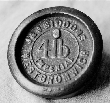
| This is a cast-iron weight by Joseph & Jesse Siddons. It is about 4 and 11/16 inches in diameter.
Note the lead plug - this is a Victorian weight.
|

| A collection of small weights. The brass 240 grain weight is by W & T Avery. It is about 1 and 1/16 inches long.
240 grains is half a Troy ounce.
|
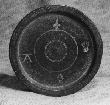
| This is a bronze weight of the reign of George III, or possibly the earlier part of the reign of George IV.
Note the relative positions of the marks - the 'dagger', the fancy A, the ewer, and the royal cypher.
|
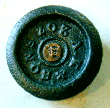
| This is a Victorian cast-iron 2oz weight - unusual in that most non-domestic 2oz weights are brass (the Board of
Trade regulations 1907, states 'No iron weight under 4oz shall be stamped'). It carries a central copper plug
with the name 'Hull', and three crowns (the badge of the city of Hull). The weight is 1 1/2 inches in diameter.
|

| This is an apothecary's 2 ounce weight. Note that this does not weigh the same as a normal(avoirdupois)2 ounce
weight - but it is the same as a 2 ounce troy weight. It is more usual to find these weights as cylinders
rather than the flat weight shown here.
|

| A George IV brass weight. Most weights of this age are bronze. It is 2 7/8 inches in diameter.
|

| A typical cast-iron weight. It is 2 1/8 inches in diameter. There is a lead plug underneath, stamped EIIR.
|

| This is a Standard weight of 50 lb Avoir, marked several times with the 'Board of Trade' portcullis.
|
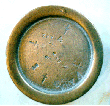
| A bronze 1lb weight, 2 13/16 inches in diameter. It is marked with the London guildhall daggers, ERY (East
Riding of Yorkshire), and VR336 (the 336 referring to the East Riding again). It is also marked ER (Edward VII).
|

| A set of inspectors weights, from 8oz to 1/2 dram. The are all marked with the Board of Trade portculis, and the
indenture number 1000 (Dudley).
|
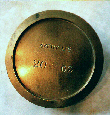
| This is a brass 20oz weight by the well-known firm of Avery. It is 3 1/2 inches in diameter. I don't know its
purpose, but the fact that 20oz is the weight of a pint of water may be significant. It would also be the weight
of £5 of silver coins (1816 to 1989).
|

| A brass 2oz (troy) cup weight - part of a nesting set. It is 1 7/16 inches wide.
|

| A bronze 4Lb weight, stamped with the ewer within the date 1826. This date is that of an act of Parliament
(the implementation of the act of 1824), not the date of manufacture of the weight.
|

| A close-up of a cast-iron 4lb weight, by A Kenrick and Sons. Note the detail in the casting.
|
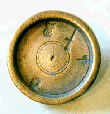
| A George I bronze weight. Note the marks: Royal cypher, ewer, dagger, and a fancy A, for avoirdupois.
|

| Seven modern bell weights. These were in use until very recently.
|

| Six cylindrical troy weights, as used by jewellers etc.
|
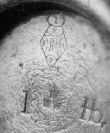
| A 'diamond' registered weight. Between 1842 and 1883, designs registered at the Patent Office Design Registry
could bear a registration mark, giving the details of the registration. After 1883, designs were issued with a simple
registration number. At the top of the mark, in a circle, is a roman one (I) - this indicates that the object is
made of metal. Immediately below it is the letter E, which refers to the year (1855). At the left of the diamond is
another E, which refers to the month (May). On the right is a 31, which is the day of the month. The 2 at the bottom
is the parcel number, which doesn't really concern us here. Also note the MW in the centre of the weight - this is
the old mark for the Manor of Wakefield.
|
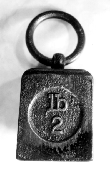
| This is a 2lb ring weight, of the sort used by the GPO (the side you can't see is has GPO and the 'broad arrow'
cast into it). The lead plug underneath is stamped EIIR. The ring is 1 5/8 inches diameter.
|

| A troy 1lb (i.e. 12 ounces) weight - quite unusual.
|
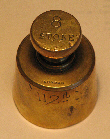
| Not a weight, but a poise to weigh 8 stones (or 112 lb - one hundredweight). It weights just over 2lb, and is
about 3" high. Made by Youngs of London.
|
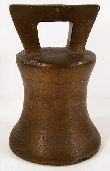
| A 'commonwealth' (1649-1659) 14lb bronze bell weight.
|
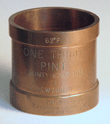
| A one-third pint measure, for the County borough of Dewsbury. It is marked 1964, and was made by W & T Jackson & Co., Leicester.
|
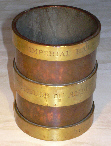
| A half pint measure. It is marked:
IMPERIAL HALF PINT
BOROUGH OF HUDDERSFIELD
1911
It is verifield GR51 (Huddersfield).
|

| An Imperial standard gallon (indenture number 927) of 1834, made for the Borough of Maldon - transferred to the
custody of the County of Essex in 1891. It is around 7 ½ inches internal diameter, and about 6 ¼ inches deep
(internal), which works out at about 276 cubic inches (an Imperial gallon is 277.4194 cubic inches, so my
measurements aren't too far out!).
|

| An Imperial standard half-bushel, indenture number 46, made for the County of Bedford. It is dated 1825 - the first year
that Imperial Standard weights and measures were issued, just before they were made legal (1826).
|

| Two pictures of an Imperial standard quarter gill made for the West Riding of Yorkshire. It carries the indenture no. 327
(Halifax town and Manor of Wakefield, issued in 1826), but bears the date 1879. It also carries the the (cancelled)
indenture no. of 1194 (Yorks West Riding, Eastern Ainsty Division, of 1857). It looks like this piece was renumbered
to fit in with an existing earlier set - there was a set of standards (indenture no. 1651) obtained for the West riding in 1879.
|

| A wooden measure for sand and ballast. It is in three parts, so can be used to measure one-half and three-quarters of a cubic
foot, as well as a whole cubic foot. Made by de Grave, Short & Co. Ltd, it was used by Durham County Council
|

| A box containing two standard pipettes, made by Avery for the 'County Palatine of Durham'
|

| Detail of the two standard pipettes shown in the previous picture. They are of 60 minims and 30 minims (at 62 degrees Farenheit).
They are marked GVIR 1938, with the indenture no. of 4907.
|
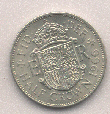
| A 1966 half-crown. This is two shillings and six pence, written as 2/6 or 2s 6d. This impressive coin was last made
for circulation in 1967, although some were made for collectors dated 1970. The coins were withdrawn from circulation
on the 31st August 1971, in common with other coins (penny, ha'penny, thre'penny bit).
|
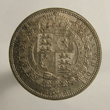
| A half-crown from 1887 - Queen Victoria's jubilee year. Note the great pride taken in coin design during that period -
observe St. George on his horse fighting the dragon between 18 & 87.
|
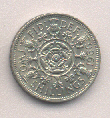
| First introduced in 1847, the florin was intended as a first step towards decimal currency (it being 1/10th of a
pound). In 1969 it metomorphised into the 10p piece (i.e. still 1/10th of a pound), retaining the same dimensions
until 1992.
|

| A 1966 English shilling. From 1937 there were two types of shilling - the English and the Scottish. Both were legal
tender - the only difference between them being the picture on the reverse. The size of the shilling remained constant
from 1816 to 1989 (by which time it was known as a 5p piece).
|
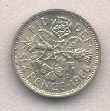
| A 1966 sixpence ('tanner'). After decimalisation it was worth 2 ½p
|
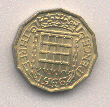
| A 1966 thre'penny bit - the twelve-sided shape made it easy to balance on its edge without rolling away - it was
always said that you could stand one on the radiator of a Rolls-Royce, when the engine was running. Alas, the
the'penny bit was consigned to history on 31st August 1971, Rolls-Royce lasting another 30 years before being
sold to a German company.
|
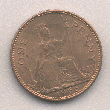
| A 1966 penny. Note the light-house at the left of Britannia - some older pennies had a ship on the horizon
on the right as well. After decimalisation, the penny was only legal tender in multiples of 6 (i.e. 2 ½p).
|
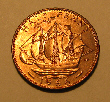
| A 1966 ha'penny. After decimalisation, pennies and ha'pennies were only tenderable as multiples of 6d (=2 ½p).
|

| A 1757 sixpence of George II. Note the 'fleur de lis' on the shield - the crown still asserting its ownership of France.
|
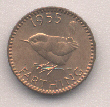
| A 1955 farthing - a quarter of a penny. The last ones were dated 1956, and they went out of circulation in 1960.
There were 960 farthings to the pound, and at one time there was a proposal to re-base the coinage so that there
were 1000 of these to the pound, the new coin being call a mil.
|

| The famous 'cartwheel' pennies and twopences made of 1 ounce (the penny) and two ounces (the twopence) of copper, by
Boulton and Watt's Soho foundry (which later became the site of the equally famous firm of W & T Avery). Two-pence
coins were only made for general circulation with this date.
|

| A ten shilling note, known universally as a 'ten bob note'.
|
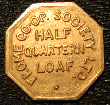
| A token for a half-quartern loaf. A half-quartern loaf would weigh 2 lb (it would be made from 1 ¾ lb of flour).
|
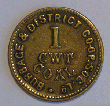
| A co-op token for one hundredweight (112 lb) of coal.
|















































